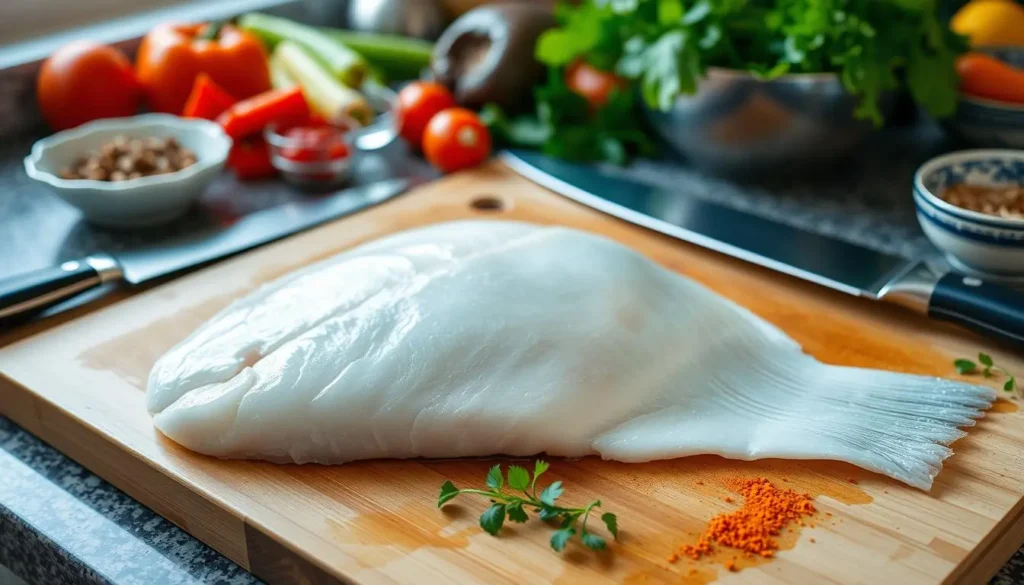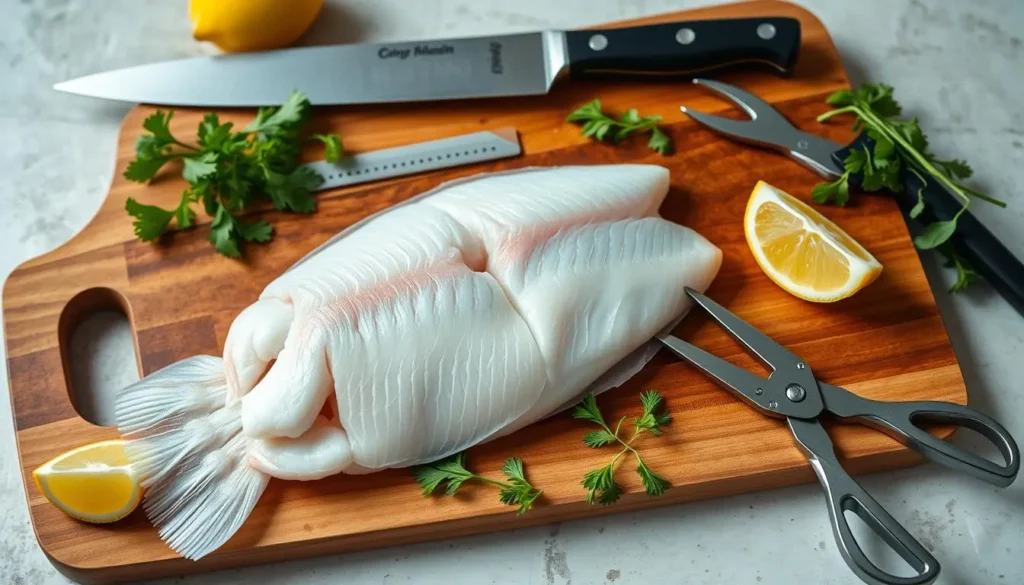Halibut is a prized white fish known for its firm, flaky texture and rich, buttery flavor. But, when preparing it, there’s a debate – should you skin the halibut before cooking or leave the skin on? This guide will explore both sides, helping you make the best choice for your halibut dish.
Key Takeaways
- Understand the benefits and drawbacks of removing halibut skin before cooking
- Discover the different types of halibut cuts and their unique characteristics
- Learn essential tools and techniques for preparing halibut for cooking
- Explore the best cooking methods for halibut, from grilling to baking
- Discover creative ways to serve halibut, such as in delicious fish tacos
But the most pressing question remains – do you skin halibut before cooking? The answer may surprise you and could be the key to unlocking the full potential of this versatile seafood. Dive into this comprehensive guide to uncover the secrets to perfectly prepared halibut, every time.

Understanding Halibut: A Premium White Fish
Halibut is a top choice for white fish lovers. It has a firm, flaky texture and a delicate taste. Chefs and home cooks love it for making dishes like halibut fish tacos shine.
Nutritional Benefits of Halibut
Halibut is packed with protein, vitamins, and minerals. It’s full of omega-3 fatty acids that are good for your heart and brain. It also has lots of selenium, vitamin B12, and phosphorus, making it great for your diet.
Different Types of Halibut Cuts
- Halibut Steaks: These thick, rectangular cuts are popular for grilling, pan-searing, and baking.
- Halibut Fillets: Halibut fillets are thin, flat cuts that are perfect for quick-cooking methods like sautéing or poaching.
- Halibut Cheeks: The tender, succulent cheek meat of the halibut is considered a delicacy and is often used in specialty dishes.
Whether you’re making a fancy seafood dish or creating a delicious batch of halibut fish tacos, halibut will impress. Its amazing flavor and texture make it a true culinary gem.
Essential Tools for Preparing Halibut
Preparing halibut, a premium white fish, needs the right tools. From filleting knives to cutting boards, the right equipment makes a big difference. It ensures a smooth and efficient process.
Filleting Knives: The Backbone of Halibut Prep
A sharp, high-quality filleting knife is key for halibut prep. Look for a flexible, narrow blade that glides through the fish’s delicate flesh easily. Choose a stainless steel or carbon steel blade for a clean, precise cut every time.
Cutting Boards: The Foundation for Halibut Prep
A sturdy, non-slip cutting board is crucial for halibut prep. Pick a board made of wood or plastic that can handle the fish’s weight. Look for boards with grooves or a juice well to catch excess liquid, keeping your area clean and organized.
Scaling Tools: Removing Halibut Scales with Ease
If you’re working with a whole halibut, you’ll need a reliable scaling tool. A handheld fish scaler or a pair of long-nose pliers works well. They help you remove the scales efficiently, preparing the halibut for further processing.
| Essential Halibut Preparation Tools | Key Features |
|---|---|
| Filleting Knife | Flexible, narrow blade for precise cuts |
| Cutting Board | Sturdy, non-slip surface with grooves/juice well |
| Scaling Tool | Handheld scaler or long-nose pliers |
Investing in the right halibut preparation tools and fish filleting equipment makes the process more efficient and enjoyable. With the proper tools, you’ll be able to create delicious halibut dishes with ease.
Do You Skin Halibut Before Cooking
Deciding whether to skin halibut before cooking can greatly affect the taste and texture of your dish. Halibut is a high-quality white fish known for its soft texture and mild taste. Knowing when to remove the skin and when to keep it can lead to better cooking results.
Benefits of Removing Halibut Skin
Removing the skin from halibut can make the fish more tender and less chewy. It also removes any fishy taste that some people dislike. Plus, it helps in achieving a crispy sear or perfect bake.
When to Keep the Skin On
Keeping the skin on halibut has its own benefits. The skin keeps the fish together while cooking, which is great for grilling or pan-searing. It also protects the delicate flesh from drying out or overcooking. Some people enjoy the flavor and texture the skin adds, especially when cooked right.
Whether to skin or not to skin halibut is up to personal taste and cooking method. Try both ways to see which works best for you.
Step-by-Step Guide to Skinning Halibut
Learning how to skin halibut can change your cooking game. Whether you’re working with a thin fillet or a thick steak, the right fish skinning techniques are key. This guide will help you remove halibut skin perfectly.
- Begin with a sharp, quality fillet knife. A sharp blade is essential for removing skin cleanly without harming the meat.
- Put the halibut on a clean, stable surface with the skin up. Make sure the fish is secure to avoid slipping.
- Find the thin membrane between the skin and flesh. Carefully insert the knife’s tip under it, avoiding too much meat damage.
- Slowly move the knife along the halibut’s length, keeping it parallel and at a steady depth. Apply gentle pressure to remove the skin.
- Use your other hand to hold the skin tight, guiding the knife for a smooth cut.
- After removing the skin, check for any leftover skin or membrane. Trim these away with the knife for a smooth finish.
With practice, you’ll get the hang of how to skin halibut. This skill opens up a world of tasty halibut dishes. Enjoy exploring new recipes with your fish skinning techniques.
Best Cooking Methods for Halibut
There are many ways to cook halibut, a top-notch white fish. You can grill, pan-sear, or bake it. Each method brings out different flavors and textures, making it great for dishes like halibut fish tacos.
Grilling Techniques
Grilling adds a smoky flavor to halibut. Make sure to oil the grates to avoid sticking. Grill over medium-high heat, flipping once, for a seared outside and tender inside. It’s perfect with fresh salsas or citrus sauces.
Pan-Searing Tips
Pan-searing makes halibut crispy. First, dry the fillets and season them well. Then, heat a skillet, add oil, and sear for 3-4 minutes on each side. This method is perfect for cooking halibut for tacos.
Baking Instructions
Baking is easy and works well for halibut. Preheat to 400°F (200°C) and line a baking sheet. Place the fish, drizzle with oil, and season. Bake for 12-15 minutes until it flakes easily. Baked halibut is great with many sides and sauces.
| Cooking Method | Flavor and Texture | Best Pairings |
|---|---|---|
| Grilling | Smoky, charred exterior, moist interior | Fresh salsas, citrus-based sauces |
| Pan-Searing | Crisp, golden-brown crust, tender center | Fish tacos, lemon-butter sauce |
| Baking | Mild, flaky texture | Roasted vegetables, herb-infused sauces |
Don’t overcook halibut to enjoy its best. It should be opaque and flaky but still moist. With practice, you’ll master cooking halibut and make tasty dishes.

Making Perfect Halibut Fish Tacos
Halibut is a top choice for fish tacos. It has a mild taste and firm texture. This makes it great for different toppings and flavors. Whether you’re a taco pro or new to halibut fish tacos, this guide will help you make the perfect dish.
Halibut is perfect for tacos because of its delicate taste and flaky texture. It blends well with taco toppings like fresh salsa and creamy sauces. Plus, halibut is lean and full of nutrients, making it a healthier option for tacos.
Preparing Halibut for Tacos
When preparing halibut for tacos, you can choose to keep the skin on or off. Leaving the skin on can make the fish crispy when pan-seared or grilled. But, removing the skin might be better for baking or sautéing.
- Rinse the halibut fillets and pat them dry with paper towels.
- If removing the skin, use a sharp knife to carefully peel it off the fish.
- Cut the halibut into bite-sized pieces, approximately 1-inch cubes.
Cooking Halibut for Tacos
After prepping the halibut, you can cook it in several ways. Grilling, pan-searing, or baking can give you the perfect texture and flavor. Choose the method that fits your taste and the taco recipe.
- Grilled Halibut: Brush the halibut with oil, season with your desired spices, and grill over medium-high heat for 3-5 minutes per side, or until cooked through.
- Pan-Seared Halibut: Heat a large skillet over medium-high heat, add a bit of oil, and sear the halibut for 2-3 minutes per side until golden brown.
- Baked Halibut: Preheat your oven to 400°F (200°C). Place the halibut on a baking sheet, drizzle with oil, and bake for 12-15 minutes, or until the fish flakes easily with a fork.
Now that the halibut is cooked, it’s time to make your halibut fish tacos. Place the fish on warm tortillas and add your favorite toppings. Enjoy the mix of flavors and textures that make halibut fish tacos a treat.
“Halibut is the unsung hero of the taco world. Its firm texture and mild flavor make it the perfect canvas for a symphony of taco toppings.”
Creating the Perfect White Sauce for Halibut
Halibut dishes are even better with the right sauce. Whether it’s classic fish tacos or new recipes, a great white sauce is essential. Let’s explore the key ingredients and tasty variations that will make your taste buds happy.
Classic Sauce Ingredients
The base of a classic white sauce is simple yet versatile. You’ll need:
- Butter
- All-purpose flour
- Milk
- Salt and pepper to taste
Start by whisking flour into melted butter to make a roux. Then, add milk and simmer. This basic mix creates a creamy sauce that lets the halibut’s flavor stand out.
Sauce Variations and Pairings
While the classic sauce is loved by many, you can also try new flavors. Think about adding:
- Lemon juice for a tangy twist
- Grated Parmesan for a savory touch
- Chopped fresh herbs like dill, chives, or parsley for freshness
- Capers for a salty, umami flavor
These small changes can turn your white sauce into the ideal match for halibut tacos, steaks, or fillets.
The secret to the perfect white sauce is finding the right balance. It’s about the creamy base and the halibut’s delicate taste. With a bit of experimentation, you’ll soon be making halibut dishes that taste like they’re from a restaurant.
Common Mistakes to Avoid When Preparing Halibut
Cooking halibut can be a delightful experience, but it’s crucial to avoid common preparation errors. These mistakes can affect the taste and texture of the dish. Halibut, being a premium white fish, needs careful handling to showcase its full potential. Let’s look at the most common mistakes and how to avoid them.
One of the most common halibut cooking tips is to avoid overcooking the fish. If halibut is cooked for too long, it can become dry and tough. To prevent this, keep a close eye on the cooking time. Use a meat thermometer to ensure the internal temperature reaches 145°F (63°C) before removing it from the heat.
Another fish preparation error to avoid is improper seasoning. Halibut has a delicate flavor that can be easily overpowered by heavy seasoning. Use a light touch with your spices and herbs, allowing the natural taste of the fish to shine.
- Avoid using too much salt, as it can make the halibut taste overly briny.
- Experiment with subtle, complementary flavors like lemon, dill, or a light butter sauce.
Finally, be mindful of the cooking method you choose. While halibut can be prepared in various ways, some techniques are better suited than others. For example, pan-searing or grilling can create a beautiful sear on the outside while keeping the interior moist and flavorful. In contrast, baking or poaching may result in a less desirable texture.
“The key to preparing halibut is to let the natural flavor of the fish shine through, without overpowering it with excessive seasoning or cooking methods.”
By avoiding these common halibut cooking tips and fish preparation errors, you’ll be well on your way to creating delicious and perfectly cooked halibut dishes. These dishes will delight your taste buds.
Storage and Freshness Tips
Keeping your halibut fresh is key. Whether you caught it yourself or bought it, knowing how to store it is important. This way, you can enjoy the best taste and texture of your halibut. Let’s explore the best ways to store halibut and how to check if it’s fresh.
Storing Halibut: The Right Way
To keep your halibut fresh, follow these steps:
- Wrap the fillets or steaks tightly in plastic wrap or place them in an airtight container.
- Put the halibut in the coldest part of your fridge. This is usually the bottom shelf or the back, where it stays between 32°F and 40°F (0°C and 4.4°C).
- If you won’t eat the halibut in 2-3 days, freeze it. Frozen halibut can last up to 6 months.
Identifying Fresh Halibut
Knowing how to spot fresh halibut is crucial. Here are some fish freshness indicators:
- A bright, shiny look with a firm, elastic feel.
- Clear, bright eyes that aren’t sunken or cloudy.
- A mild, ocean-like smell. A fresh halibut shouldn’t smell fishy.
- Bright red or pink gills.
By following these tips, you can enjoy the best flavor and texture of your halibut. Every meal will be a seafood treat.
Seasoning and Marinade Ideas
Enhancing the taste of halibut is easy. A few simple seasonings and marinades can bring out its best. Let’s dive into some tasty options that will make your taste buds happy.
Dry Rub Combinations
Making a flavorful dry rub is simple. Mix together:
- Garlic powder
- Paprika
- Dried oregano
- Salt and pepper
- Cayenne pepper (for a kick of heat)
Coat the halibut fillets with the dry rub. Let them sit for 30 minutes before cooking. This will make the fish taste amazing when seared or baked.
Marinade Recipes
For deeper flavors, try these marinades:
- Lemon-Herb Marinade: Whisk olive oil, lemon juice, parsley, dill, salt, and pepper.
- Teriyaki Marinade: Mix soy sauce, rice vinegar, brown sugar, garlic, and ginger for an Asian twist.
- Creamy Dill Marinade: Combine Greek yogurt, lemon juice, Dijon mustard, and fresh dill for a tangy marinade.
Marinate the halibut for 30 minutes to 2 hours before cooking. This will make the flavors blend beautifully.

“The key to unlocking the full flavor of halibut is all in the seasoning and marinades. Experiment with bold spices, fresh herbs, and acidic ingredients to find your perfect flavor profile.”
Conclusion
Halibut is a versatile and premium white fish that offers a delightful culinary experience when prepared correctly. You’ve learned the importance of removing the skin and mastering various cooking techniques. This unlocks the full potential of this delectable seafood.
Whether you prefer grilling, pan-searing, or baking your halibut, the right approach can elevate the natural flavors. This produces a mouthwatering dish. Try pairing your expertly cooked halibut with a creamy white sauce or bold seasoning and marinade ideas to find your personal favorite.
As you continue your halibut cooking journey, remember to always prioritize freshness, storage, and proper preparation methods. By following the techniques and tips outlined in this guide, you’ll become a halibut preparation pro. You’ll be able to consistently deliver restaurant-quality results in your own kitchen.
FAQ
Is halibut a good fish to use for fish tacos?
Yes, halibut is a great choice for fish tacos. It has a mild flavor that goes well with taco toppings and sauces. Its firm texture also makes it easy to cook and assemble.
What is the best kind of fish to use for fish tacos?
Halibut is a top choice for fish tacos. It tastes mild and has a firm, flaky texture. This makes it great for holding up against bold toppings and sauces.
What is the white sauce on fish tacos made of?
The white sauce in fish tacos is creamy and tangy. It’s made with mayonnaise, sour cream, lime juice, and spices like garlic and cumin. This sauce balances the flavors and adds a cool contrast to the spicy parts of the tacos.
Do you skin halibut before cooking?
Whether to skin halibut before cooking depends on your preference and the dish. Removing the skin makes the fish flaky and delicate. Leaving the skin on adds flavor and helps the fish stay firm, especially in dishes like fish tacos.
What are the benefits of removing the skin from halibut?
Taking off the skin from halibut offers several advantages. It makes the fish flaky and delicate, better for absorbing flavors, and looks cleaner. This is especially good for fish tacos, where the skin might affect the texture and look.
When should you keep the skin on halibut?
It’s better to keep the skin on halibut for grilling or pan-searing. The skin helps the fish stay firm and adds flavor. It also protects the delicate flesh when baking or roasting, preventing it from drying out.

